Keep up with the latest IoT-based building automation, and follow us on LinkedIn!
Introduction
Building management system (BMS) is a vital tool for ensuring efficient and effective operation of modern buildings. Whether it’s a commercial office building, retail store, hotel, manufacturing plant, or warehouse, a BMS can help to monitor, control, and optimize the various systems and components that keep a building running smoothly.
In this blog, we’ll explore the various components of a BMS and how they work together to manage a building. We’ll also take a quick dive into the history of BMS technology, the different types of BMS available, and the key considerations involved in designing and implementing a BMS.
Furthermore, we’ll discuss the importance of maintenance and support for a BMS, the trends and advancements in BMS technology, and what the future might hold for these systems.
Whether you’re an engineer, a facility manager, or simply someone interested in building technology, this blog will provide a comprehensive overview of building management systems and their role in modern facilities management. So let’s get started!
Definition of a building management system (BMS)
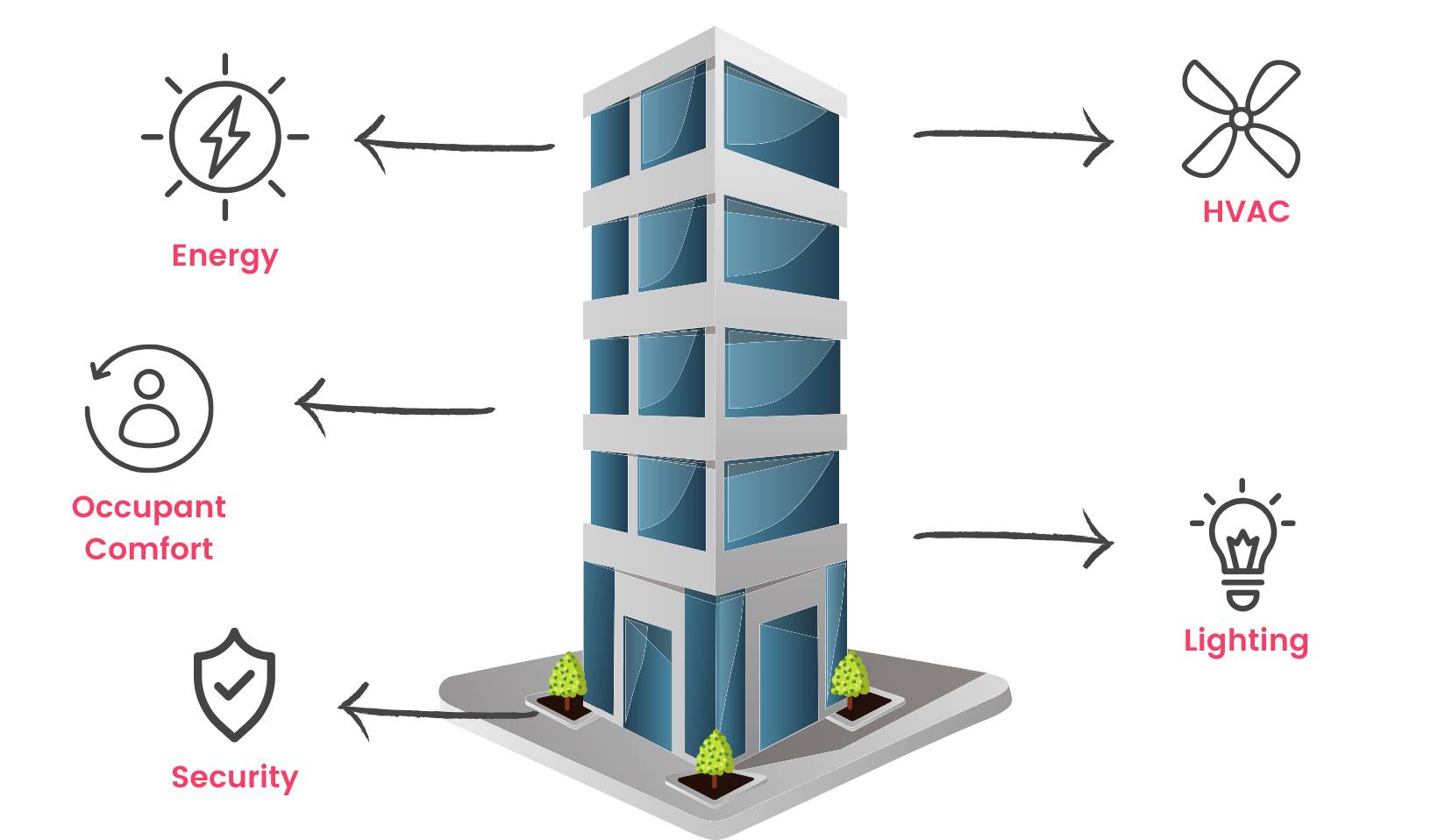
A building management system (BMS) is a computer-based control system installed in buildings that monitors and controls a facility’s mechanical and electrical equipment, such as heating, ventilation, and air conditioning (HVAC), lighting, and power systems. The goal of a BMS is to improve the energy efficiency, comfort, and safety of a building and reduce operating costs.
A BMS typically consists of a central control system that is connected to various sensors and actuators located throughout the building. The control system collects data from the sensors and uses this data to adjust the operation of the building’s systems and equipment in real time.
A BMS can be standalone, meaning it controls only a single building or can be integrated with other systems to control multiple buildings or even an entire campus. An advanced BMS can also be IoT-based or cloud-based, which is hosted on a remote server and accessed via the internet rather than installed on-site.
Overview of the various components that make up a BMS
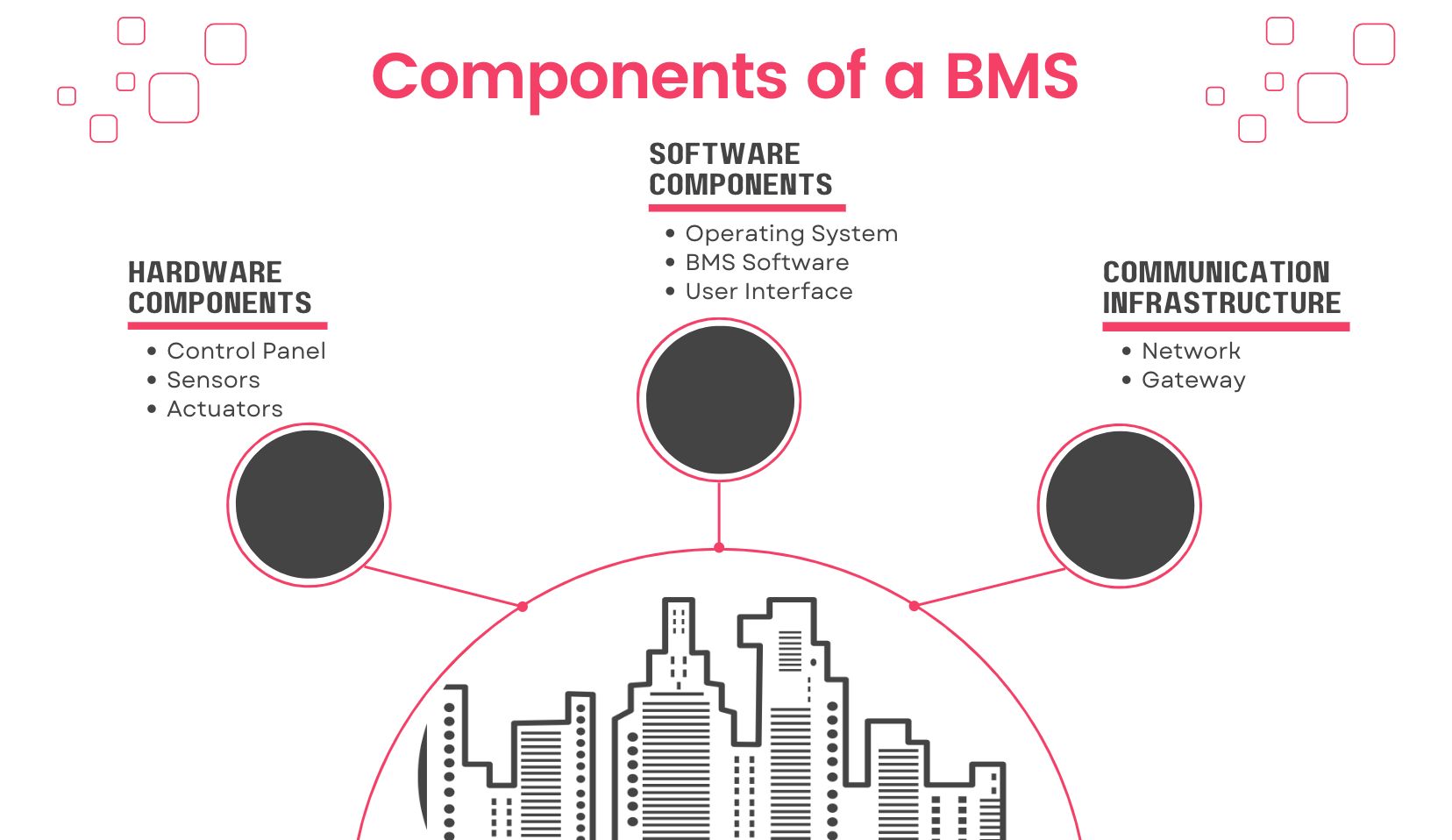
1. Hardware components:
- Control panel: This is the central hub of the BMS. It’s responsible for collecting data from the sensors, processing it, and issuing commands to the actuators. The control panel can be a standalone computer or a network of computers and is typically located in a secure room within the building.
- Sensors: These are the devices that measure various parameters within the building, such as temperature, humidity, occupancy, energy usage, etc. Sensors are typically connected to the control panel via wired or wireless networks.
- Actuators: These are the devices that carry out the commands issued by the control panel, such as switching the lights, adjusting the temperature of an area, etc. Actuators can be electrical or mechanical in nature.
2. Software components:
- Operating system: This is the underlying software that powers the control panel and enables it to communicate with the sensors and actuators.
- BMS software: This is the application software that runs on top of the operating system and provides the functionality specific to the BMS, such as data collection, analysis, and control. BMS software can be proprietary, meaning it’s developed by the manufacturer of the BMS, or it can be open source, meaning it’s developed and maintained by a community of users.
- User interface: This is the interface that users, such as facility managers or building operators, interact with to monitor and control the building management system. The user interface can be a web-based portal, a mobile app, or a physical panel.
3. Communication infrastructure:
- Network: This is the infrastructure that interconnects the various components of the BMS, such as the control panel, sensors, and actuators. The network can be wired or wireless and can use a variety of protocols, such as Ethernet, Wi-Fi, BACnet, Modbus, etc.
- Gateway: This is a device that connects the BMS to other systems or networks, such as the internet, user dashboard, or a supervisory control and data acquisition (SCADA) system. The gateway acts as a translator, enabling the BMS to communicate with these other systems using different protocols.
Benefits of using an advanced BMS
1. Energy efficiency
A BMS can help to optimize the operation of a building’s mechanical and electrical systems, such as heating, ventilation, and air conditioning (HVAC), lighting, power systems, etc.
By automatically turning off lights and equipment when they are not needed and by adjusting the temperature and humidity of a building based on occupancy and other factors, a BMS can significantly reduce a building’s energy consumption and lower its energy bills.
2. Comfort
A BMS can help maintain a comfortable environment for building occupants by controlling the building’s temperature, humidity, and air quality. It can also ensure that the lighting in a building is appropriate for the task at hand and that the building’s systems are operating smoothly.
3. Safety
A BMS can help to ensure the safety of a building’s occupants by detecting and responding to emergencies, such as fires, leaks, or power outages. It can also help to prevent accidents by automatically shutting off equipment when it’s not in use or by alerting maintenance staff when equipment needs to be serviced.
4. Reduced operating costs
By optimizing the operation of a building’s systems and equipment, a BMS can help to reduce the cost of maintaining and operating the building. It can also help extend the lifespan of a building’s systems and equipment by detecting and addressing problems before they become major.
5. Improved asset management
A BMS can provide valuable data on the performance and usage of a building’s systems and equipment, which can help facility managers to make informed decisions about maintenance, repairs, and upgrades. It can also help to optimize the scheduling of maintenance activities and to reduce the risk of equipment failure.
6. Enhanced security
A BMS can help to secure a building by controlling access to the building and its various areas and by monitoring for unusual activity. It can also help protect against unauthorized access to the BMS by implementing secure authentication and access controls.
History of building management systems

The history of building management systems (BMS) can be traced back to the early days of building automation when simple control systems were used to regulate the temperature and ventilation of large public buildings.
One of the first known examples of a building automation system is the “pneumatic tube system“, developed in the late 19th century, which used a network of tubes to transmit control signals from a central panel to pneumatic actuators located throughout the building. These actuators would then open or close dampers and valves to adjust the air and steam flow in the building’s heating and ventilation systems.
Evolution of Building Management Systems (BMS) technology over time
Over the years, BMS technology has evolved significantly, with the introduction of new sensors, actuators, and control algorithms that enable more sophisticated and efficient control of a building’s systems. Some of the key milestones in the history of BMS include:
The 1950s: The development of programmable logic controllers (PLCs), which are small, rugged computers that can be programmed to control industrial processes. PLCs became widely used in building automation systems.
The 1970s: The development of the building automation system (BAS), a computer-based control system that monitors and controls mechanical and electrical systems. BAS systems became popular in the 1980s as they provided a more flexible and cost-effective alternative to traditional hardwired control systems.
The 1980s: The development of the supervisory control and data acquisition (SCADA) system, which is a type of BMS that is used to monitor and control large, complex facilities, such as power plants, water treatment plants, and manufacturing plants. SCADA systems became popular in the 1990s, as they provided a way to remotely monitor and control geographically dispersed systems.
The 1990s: The development of the internet made it possible to remotely access and control building automation systems using web-based interfaces. This enabled facility managers to monitor and control their buildings from anywhere with an internet connection.
The 2000s: The development of cloud-based BMS, hosted on a remote server and accessed via the internet rather than being installed on-site. IoT-based BMS became popular in the 2010s, as they provided a cost-effective and scalable solution for managing multiple buildings or even an entire campus.
The Evolution of IoT-BMS: Past, Present & Future
Advancements in BMS development
1. Adoption of Internet of Things (IoT) technologies
2. Development of predictive analytics
3. Integration with other systems
4. Development of mobile apps
The development of mobile apps has made it easier for building occupants and facility managers to interact with the BMS and has enabled the BMS to provide a more personalized experience. Mobile apps can be used to adjust the temperature of a room, control the lighting, report maintenance issues, and provide real-time feedback & alerts to users, etc.
Types of Building Management Systems
Several types of building management systems (BMS) are used to monitor and control different mechanical and electrical systems of a building. The type of BMS best suited for a particular building depends on the size and complexity of the building, the type of systems it already has, and the specific needs of the building’s occupants.
1. Standalone BMS
A standalone BMS is a BMS that controls only a single building. It typically consists of a central control panel that is connected to various sensors and actuators located throughout the building.
It uses pre-programmed rules and setpoints to adjust the operation of the building’s systems in real time. A standalone BMS is better suited for small to medium sized buildings.
2. Integrated BMS
An integrated BMS is a BMS that controls multiple buildings or an entire campus. It also consists of a central control panel that is connected to various sensors and actuators located throughout the buildings.
An integrated BMS is suitable for large, complex facilities, such as universities, hospitals, or corporate campuses.
3. IoT-based BMS
An IoT-based BMS is hosted on a remote server and accessed via the internet rather than on-site. It can be used to control a single building, multiple buildings, or an entire campus.
IoT-based BMS is the most advanced & versatile building management system suitable for all kinds of buildings & infrastructures like retail stores, hotels, industrial plants, offices, warehouses, data centers, etc.
Role of BMS components and how they work together to manage a building
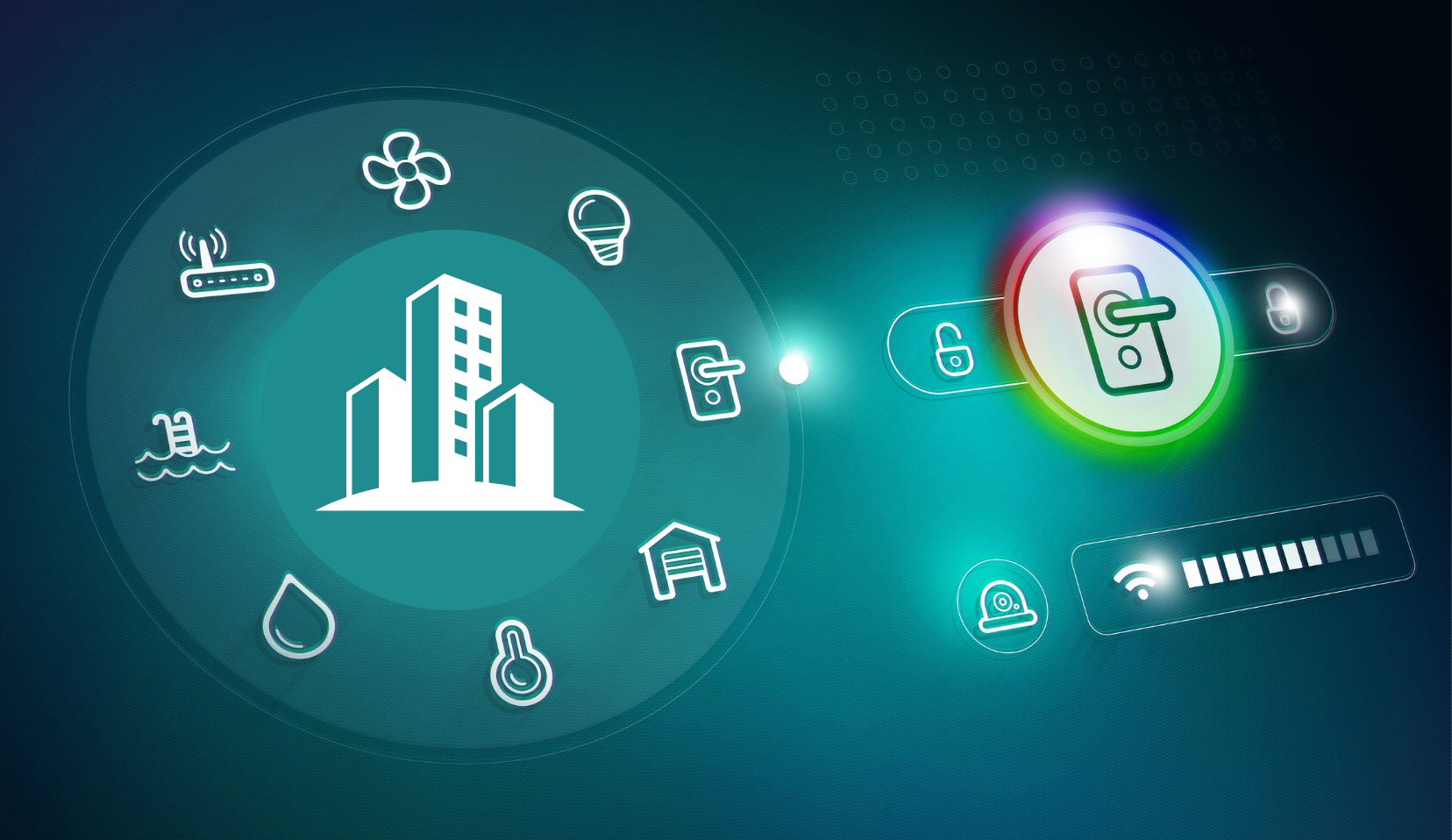
The components of a building management system (BMS) work together to manage a building as follows:
1. Sensors
Sensors are devices used to measure various conditions within a building, such as temperature, humidity, light levels, occupancy, and air quality. Sensors are connected to the BMS and transmit real-time data to the control panel.
2. Actuators
Actuators are devices used to control various assets & equipment within a building, such as HVAC, lighting, and power. Actuators are connected to the BMS and can be controlled by the control panel in real time based on the data collected by the sensors.
3. Control panel
The control panel is the central hub of the BMS. It’s typically a computer or a group of computers connected to the sensors and actuators. They use pre-programmed rules and setpoints to adjust the operation of the building’s systems.
The control panel receives data from the sensors and uses this data to determine the appropriate actions to take, such as adjusting the temperature of a room, switching lights, etc.
4. Communication network
The communication network is the infrastructure that connects the various components of the BMS, such as the sensors, actuators, and control panel. The communication network transmits data between these components, allowing the control panel to receive data from the sensors and control the actuators.
5. User interface
The user interface is the interactive interface the facility manager uses to access and control the BMS. It can be a physical control panel, a web-based interface, or a mobile app. It allows the facility manager to monitor the status of the building’s systems and adjust the operation of the systems as needed.
Together, these components work to monitor and control the various assets within a building, such as the HVAC, lighting, and power systems, in order to optimize energy efficiency, comfort, and safety.
Designing a building management system
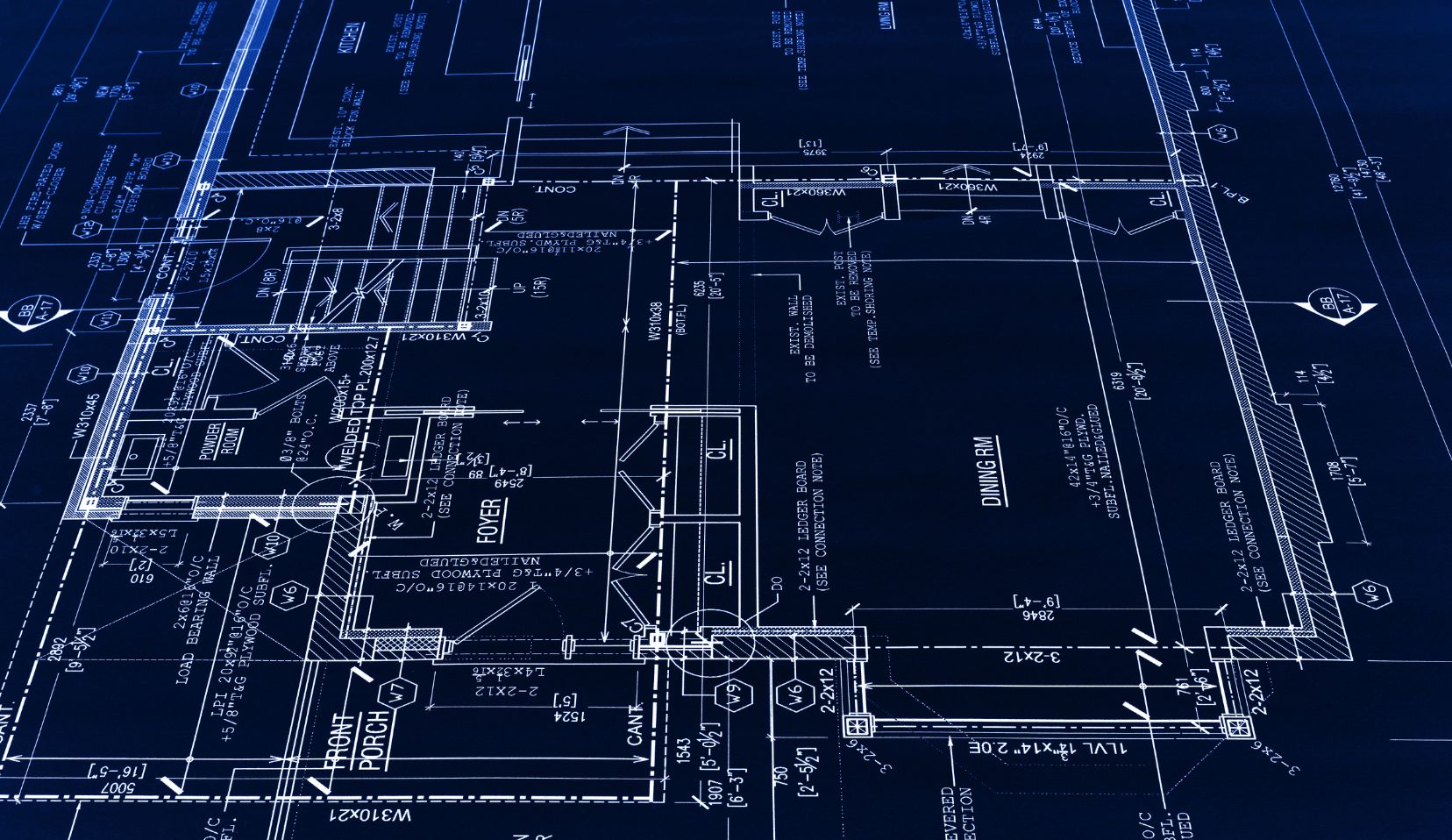
Designing a building management system (BMS) involves creating a system that monitors and controls the various assets & equipment within a building, such as HVAC, lighting, refrigeration, power systems, etc. in order to optimize energy efficiency, assets, occupant comfort, and safety.
The design of a BMS is driven by the goals and objectives of the system and should take into account the type & size of the building, the assets present in the building, the needs & preferences of the occupants, and the budget for the system.
Let’s explore the factors that should be considered, and the steps involved in designing a BMS.
Factors to consider when designing a BMS
Several factors should be considered when designing a building management system (BMS). Such as:
1. Goals and objectives
The first and most important factor to consider is the goals & objectives you want to achieve by implementing a BMS. These goals & objectives should drive the design of the system and should be used to determine the type of BMS, the components that are needed, and the control algorithms that will be used.
2. Building type and size
The type and size of the building should be taken into account when designing a BMS. A small retail will have different needs than a large hotel, and the BMS should be designed accordingly.
3. Building assets & equipment
The systems that are present in the building, such as the HVAC, lighting, refrigeration systems, power systems, etc. should be taken into account when designing a BMS. The BMS should be able to monitor and control these systems in order to achieve the set goals & objectives.
4. Occupant needs
The needs & preferences of the building occupants should be considered when designing a BMS. For instance, if the occupants are concerned about food safety, the BMS should have the functionality to optimize refrigeration equipment in a way that maintains the food safety compliances at all times.
5. Budget
The budget is also a major factor when designing the system. It’s important to choose components that are cost-effective. And also, prioritize the features and functionality that are most important for achieving the set goals & objectives of the BMS.
6. Scalability
The BMS should be designed to be scalable so that it can be modified as the needs of the building evolve over time. This might include the ability to add new sensors, actuators, or other components or to integrate with other systems or devices.
Steps involved in designing a BMS
Designing a building management system (BMS) involves the following steps:
1. Identify the goals & objectives of the BMS
The first step in designing a BMS is to identify the goals and objectives of the system. These goals usually include reducing energy consumption, improving occupant comfort, increasing building efficiency, enhancing security, etc.
2. Conduct a building assessment
The next step is to thoroughly assess the building to determine its current systems and conditions. This assessment might include evaluating the HVAC, lighting, power, and other systems.
3. Determine the type of BMS
Based on the goals & objectives of the BMS and the results of the building assessment, the next step is to determine the type of BMS best suited for the building. This might include a standalone BMS, an integrated BMS, or an IoT-based BMS (Cloud-based BMS).
4. Select the components
Based on the type of BMS, the next step is to select the sensors, actuators, control panel, communication network, and user interface that will be used to monitor and control building assets. It’s important to choose components that are compatible with each other, and that meet the needs of the building.
An IoT-based BMS is compatible with all assets & equipment of any technological era. It’s one of the reasons why IoT-based BMS is the most versatile & successful type of BMS.
5. Develop the control algorithms
The control algorithms are the rules and setpoints that the BMS uses to adjust the operation of the building systems. The control algorithms should be developed based on the goals and objectives of the BMS and should be tested and validated to ensure that they are effective.
6. Install and commission the BMS
The final step is to install and commission the BMS. This includes installing the sensors, actuators, gateway and other components of the system and then configuring the control panel & user interface. The BMS should be tested and calibrated to ensure that everything is functioning correctly.
Implementing a building management system
The implementation of a BMS requires careful planning and execution, as it involves installing and configuring hardware & software then integrating the BMS with the building’s assets & equipment.
Steps involved in implementing a BMS
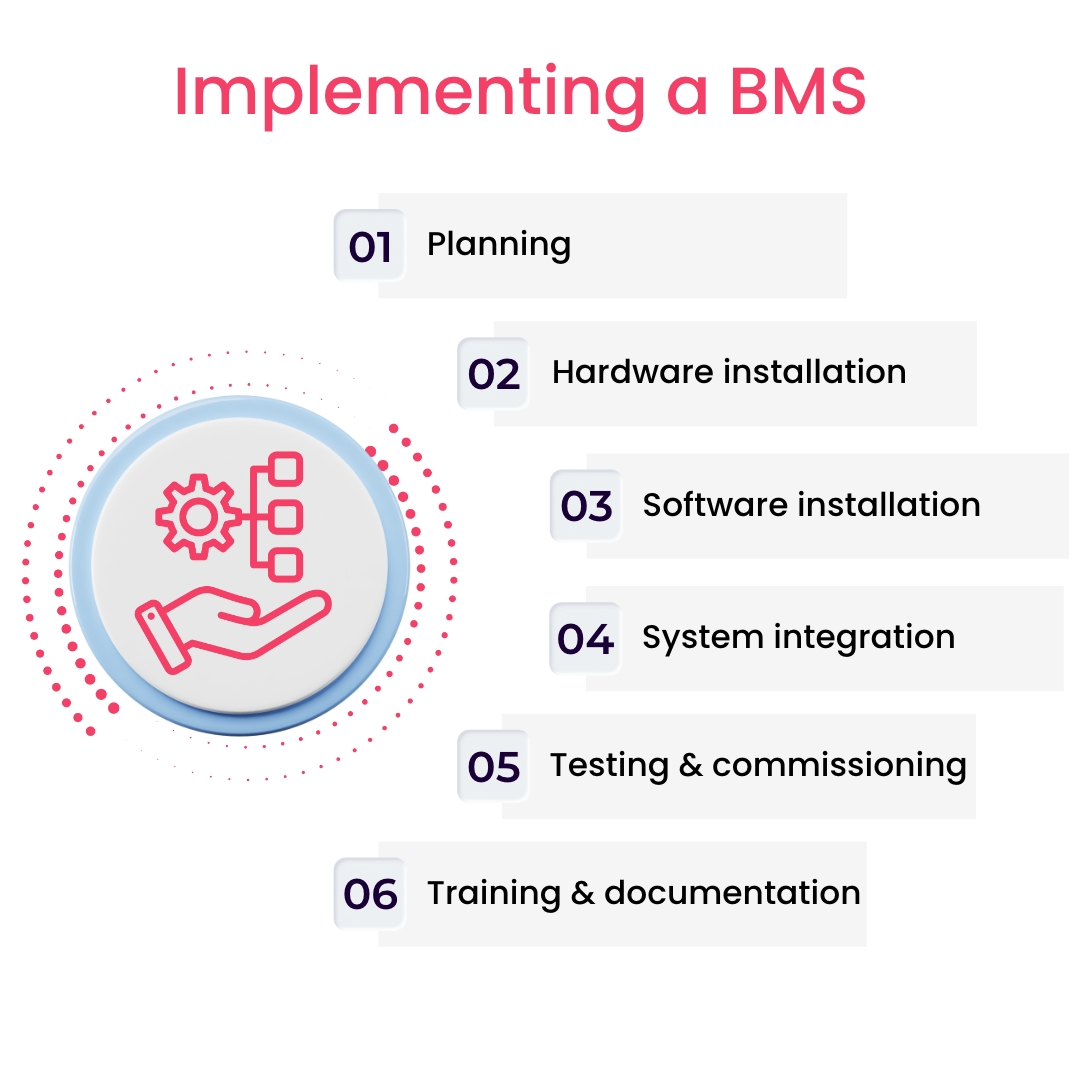
1. Planning
The first step in implementing a BMS is to plan the rollout of the system. This includes determining the scope of the project, setting timelines & milestones, and establishing a budget.
It’s also important to involve all relevant stakeholders in the planning process, including the building owner, facility manager, maintenance head, and any external contractors or vendors who will be involved in the project.
2. Hardware installation
The next step is to install the hardware components of the BMS, including the sensors, actuators, control panel, and communication network. This typically involves physically installing the components in the building and connecting them to the control panel via communication protocols.
3. Software installation
Once the hardware components are installed, the next step is to install the software that will be used. This might include the control algorithms, user interface, and any other software required for the BMS to function.
4. System integration
The BMS should be integrated with the building assets & equipment. This might involve configuring the BMS to communicate with these equipment or integrating the BMS with other systems or devices, such as occupancy sensors or smart thermostats.
5. Testing and commissioning
Once the BMS is installed and configured, it should be tested and commissioned to ensure it’s functioning correctly. This might involve conducting a series of tests to verify that the BMS is able to monitor and control the building’s systems as intended.
6. Training and documentation
It’s important to provide training to the facility manager and other relevant stakeholders on how to use and maintain the BMS. Documentation, such as user manuals and training materials, should also be provided to help users understand the capabilities and limitations of the system.
Tips for successful Building Management System (BMS) implementation
1. Clearly define the goals of the BMS
Before implementing a BMS, it’s important to define the goals & objectives clearly. This will help ensure that the BMS is tailored to meet the specific needs of the building and will provide a benchmark against which the success of the BMS can be measured.
2. Choose the right hardware and software
It’s also important to choose hardware and software components that are compatible with each other and meet the specific needs of the building. Careful selection of components will help ensure that the BMS is reliable, efficient, and easy to use.
3. Test and validate the system before going live
It’s imperative to test and validate the BMS to ensure that it’s functioning correctly and meeting the system’s goals. This might involve conducting a series of tests to verify that the BMS is able to monitor & control the building’s systems as intended.
4. Training and documentation
It’s crucial to train the facility manager and other relevant stakeholders on how to use and maintain the BMS. Documentation, such as user manuals and training materials, should also be provided to help the users.
5. Regularly monitor and maintain the BMS
To ensure that the BMS continues to function effectively, it’s vital to monitor and maintain the system regularly. This might involve checking the status of the sensors, actuators, and other components and making any necessary repairs or upgrades.
Maintenance of a building management system
Maintaining a building management system (BMS) is important to ensure that the system continues to function effectively. Here are some considerations for maintaining a BMS:
1. Establish a maintenance schedule
It’s important to establish a regular maintenance schedule for the BMS and stick to it. This might involve inspecting the sensors, actuators, and other components of the system on a monthly or quarterly basis.
2. Keep the system up to date
It’s essential to keep the BMS up to date with the latest software and firmware updates. This can help ensure that the system is secure and can take advantage of any new features or improvements available.
3. Monitor the system regularly
Regular monitoring of the BMS can help identify any issues or failures that might occur. This might involve checking the system logs, conducting periodic tests, or inspecting the components visually.
4. Address any issues promptly
If any issues are identified with the BMS, it’s critical to address them as quickly as possible. This might involve repairing or replacing faulty components, updating software, or modifying the control algorithms.
5. Seek external support as needed
If the facility manager is not able to address issues or failures with the BMS, it might be necessary to seek external support. This might involve working with the service provider of the BMS or hiring a third-party service provider to provide maintenance and support services.
6. Keep documentation and training materials up to date
It’s essential to keep documentation and training materials for the BMS up to date so that all the relevant stakeholders are able to understand and use the system effectively. This might involve updating user manuals, creating new training materials, or providing additional training as required.
Regular maintenance is imperative for a building management system as it helps ensure the system continues to function effectively. Regular maintenance of a BMS results in improved reliability, enhanced performance, increased lifespan of the assets, enhanced security, etc.
A quick recap of the key points covered
- A BMS is a system that monitors and controls the various systems within a building in order to optimize energy efficiency, comfort, and safety.
- The design of a BMS is driven by the goals & objectives of the system and should take into account the type & size of the building, the systems that are present in the building, the needs & preferences of the occupants, and the budget for the system.
- There are several steps involved in implementing a BMS, including planning, hardware installation, software installation, system integration, testing & commissioning, and training & documentation.
- Successful BMS implementation requires careful planning and execution, and involves choosing the right hardware and software components, testing and validating the system before going live, and providing training & documentation to users.
- Maintaining a BMS involves establishing a regular maintenance schedule, keeping the system up to date, monitoring the system regularly, promptly addressing any issues or failures, and seeking external support as needed.
- Regular maintenance and support are important for ensuring that a BMS is able to meet the needs and expectations of the building and provide long-term value.
Trends and advancements in BMS technology and what the future might hold
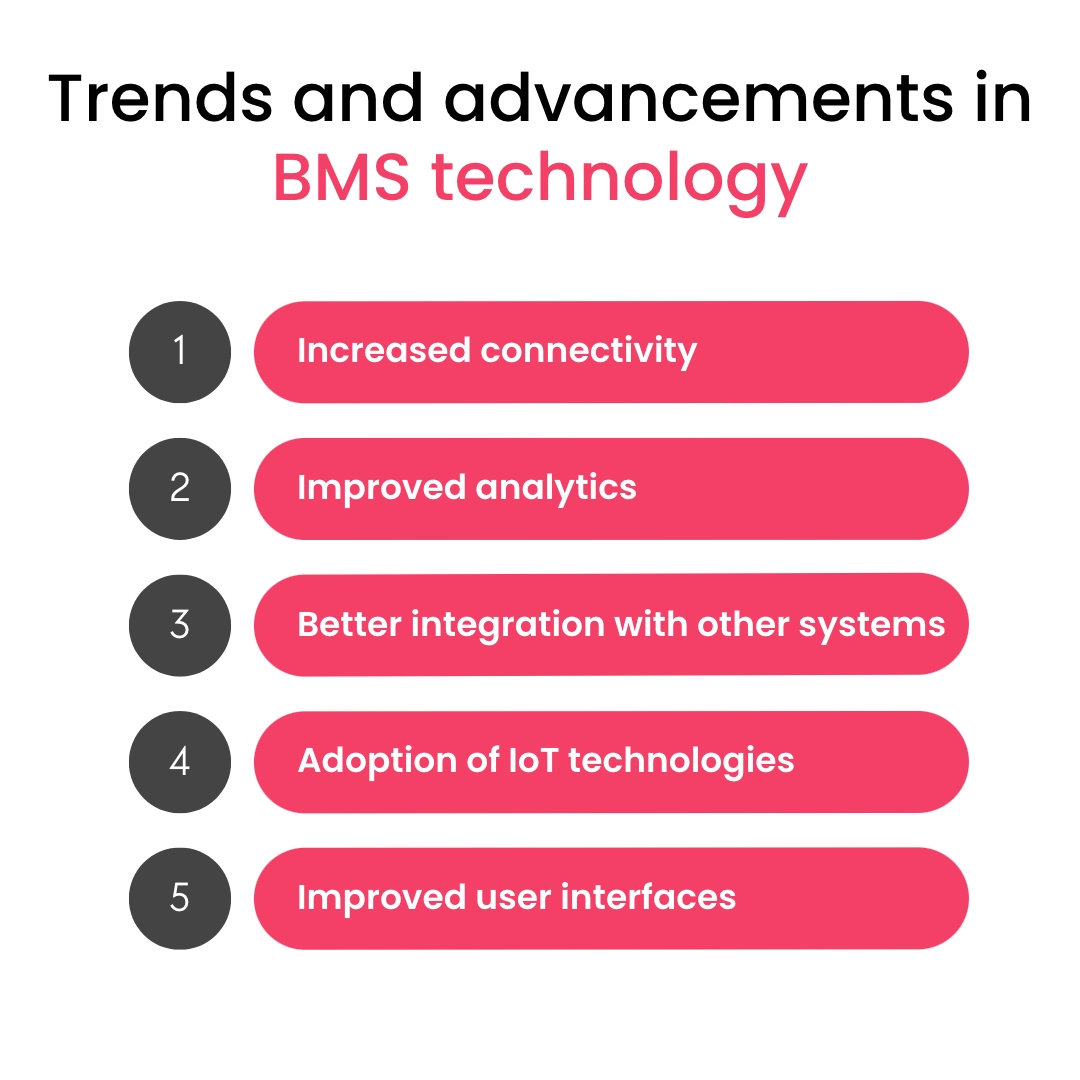
There have been several trends & advancements in BMS technology in recent years, and the future of these systems looks bright. Here are a few examples of trends & advancements in BMS technology:
1. Increased connectivity
Many building management systems are now able to communicate with a wide range of devices & systems, such as occupancy sensors, smart thermostats, and energy management systems. This allows the BMS to access a wealth of data that can be used to optimize the operation of the building systems.
2. Improved analytics
Another trend is the use of advanced analytics to improve the performance of BMS. Advanced data analytics can help identify patterns & trends in the data collected by the BMS and can be used to optimize the operation of the building systems in real time.
3. Better integration with other systems
BMSs are increasingly being integrated with other systems, such as security systems, emergency response systems, and maintenance management systems. This allows the BMS to access a wider range of data and be used for various applications.
4. Increased adoption of IoT technologies
The Internet of Things (IoT) is playing an increasingly important role in BMS technology. Many BMSs are now able to communicate with a wide range of IoT devices, such as smart thermostats, occupancy sensors, and smart appliances. This makes IoT-based BMS much more cost-effective, reliable, versatile, easy to implement & scale.
5. Improved user interfaces
Another trend is the use of improved user interfaces, such as mobile apps and web portals, to make it easier for users to interact with the BMS. These interfaces allow users to monitor and control the building systems from any location and can provide real-time data and alerts.
In the future, BMS will continue to evolve and become more sophisticated as new technologies become available and the needs of building owners and occupants change. Some potential developments in BMS technology include using artificial intelligence, integrating renewable energy systems, and using virtual reality for training and maintenance.
Keep up with the latest IoT-based building automation, and follow us on LinkedIn!


